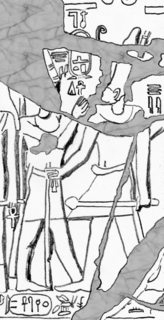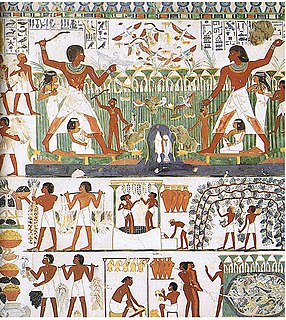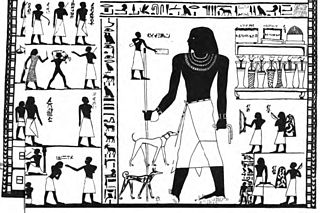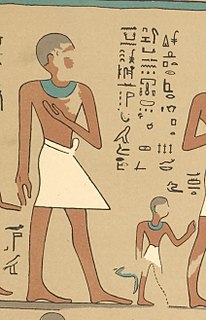
The Middle Kingdom of Egypt is the period in the history of ancient Egypt following a period of political division known as the First Intermediate Period. The Middle Kingdom lasted from around 2050 BC to around 1710 BC, stretching from the reunification of Egypt under the reign of Mentuhotep II of the Eleventh Dynasty to the end of the Twelfth Dynasty. The Eleventh Dynasty ruled from Thebes and the Twelfth Dynasty ruled from el-Lisht. Some scholars also include the Thirteenth Dynasty of Egypt wholly into this period as well, in which case the Middle Kingdom would finish around 1650, while others only include it until Merneferre Ay around 1700 BC, last king of this dynasty to be attested in both Upper and Lower Egypt. During the Middle Kingdom period, Osiris became the most important deity in popular religion. The Middle Kingdom was followed by the Second Intermediate Period of Egypt, another period of division that involved foreign invasions of the country by the Hyksos of West Asia.

Wahankh Intef II was the third ruler of the Eleventh Dynasty of Egypt during the First Intermediate Period. He reigned for almost fifty years from 2112 BC to 2063 BC. His capital was located at Thebes. In his time, Egypt was split between several local dynasties. He was buried in a saff tomb at El-Tarif.

Senusret I, also anglicized as Sesostris I and Senwosret I, was the second pharaoh of the Twelfth Dynasty of Egypt. He ruled from 1971 BC to 1926 BC, and was one of the most powerful kings of this Dynasty. He was the son of Amenemhat I. Senusret I was known by his prenomen, Kheperkare, which means "the Ka of Re is created."

Khakheperre Senusret II was the fourth pharaoh of the Twelfth Dynasty of Egypt. He ruled from 1897 BC to 1878 BC. His pyramid was constructed at El-Lahun. Senusret II took a great deal of interest in the Faiyum oasis region and began work on an extensive irrigation system from Bahr Yussef through to Lake Moeris through the construction of a dike at El-Lahun and the addition of a network of drainage canals. The purpose of his project was to increase the amount of cultivable land in that area. The importance of this project is emphasized by Senusret II's decision to move the royal necropolis from Dahshur to El-Lahun where he built his pyramid. This location would remain the political capital for the 12th and 13th Dynasties of Egypt. The king also established the first known workers' quarter in the nearby town of Senusrethotep (Kahun).

Lisht or el-Lisht is an Egyptian village located south of Cairo. It is the site of Middle Kingdom royal and elite burials, including two pyramids built by Amenemhat I and Senusret I. The two main pyramids were surrounded by smaller pyramids of members of the royal family, and many mastaba tombs of high officials and their family members. They were constructed throughout the Twelfth and Thirteenth Dynasties. The site is also known for the tomb of Senebtisi, found undisturbed and from which a set of jewelry has been recovered. The pyramid complex of Senusret I is the best preserved from this period. The coffins in the tomb of Sesenebnef present the earliest versions of the Book of the Dead.

Khaneferre Sobekhotep IV was one of the more powerful Egyptian kings of the 13th Dynasty, who reigned at least eight years. His brothers, Neferhotep I and Sihathor, were his predecessors on the throne, the latter having only ruled as coregent for a few months.

Nubkheperre Intef was an Egyptian king of the Seventeenth dynasty of Egypt at Thebes during the Second Intermediate Period, when Egypt was divided by rival dynasties including the Hyksos in Lower Egypt. He is known to be the brother of Sekhemre-Wepmaat Intef—and this king's immediate successor—since he donated Louvre Coffin E3019 for this king's burial which bears an inscription that it was donated for king Sekhemre Wepmaat Intef "as that which his brother, king Antefgives", notes Kim Ryholt. As the German scholar Thomas Schneider writes in the 2006 book Ancient Egyptian Chronology :

Meir is a village in Upper Egypt. It is located on the west bank of the Nile, in the Asyut Governorate, some 7 kilometers southwest of el-Qusiya (Cusae). The modern village is situated at coordinates 27°27′00″N30°45′00″E, while the necropolis is located at 27°25′00″N30°43′00″E.

The Theban Tomb TT60 is located in Sheikh Abd el-Qurna, part of the Theban Necropolis, on the west bank of the Nile, opposite to Luxor. It is the burial place of a woman called Senet. She was related to the Ancient Egyptian Vizier Intefiqer. It is one of the earliest burials in the area.

The Pyramid of Amenemhet I is an Egyptian burial structure built at Lisht by the founder of the Twelfth Dynasty of Egypt, Amenemhet I.

Sekhemre Sankhtawy Neferhotep III Iykhernofret was the third or fourth ruler of the Theban 16th Dynasty, reigning after Sobekhotep VIII according to egyptologists Kim Ryholt and Darrell Baker. He is assigned a reign of 1 year in the Turin Canon and is known primarily by a single stela from Thebes. In an older study, Von Beckerath dated Neferhotep III to the end of the 13th Dynasty.

El Kab is an Upper Egyptian site on the east bank of the Nile at the mouth of the Wadi Hillal about 80 kilometres (50 mi) south of Luxor. El Kab was called Nekheb in the Egyptian language, a name that refers to Nekhbet, the goddess depicted as a white vulture.

The Egyptologists Nina M. Davies and Norman de Garis Davies were a married couple of illustrators and copyists who worked in the early and mid-twentieth century drawing and recording paintings in Egypt. Their work was often published together, as N. de Garis Davies, and so it is usually difficult to determine who drew which illustration.

Djehutihotep was an ancient Egyptian nomarch of the fifteenth nomos of Upper Egypt during the twelfth dynasty, c. 1900 BC.

Amenemhat, often reported with his short form Ameny (Jmnjj), was an ancient Egyptian "Overlord of the Oryx nome" and chief priest during the reign of pharaoh Senusret I of the 12th Dynasty.

Senebtisi was an Ancient Egyptian woman who lived at the end of the 12th Dynasty, around 1800 BC. She is only known from her undisturbed burial found at Lisht.

Sarenput II, also called Nubkaurenakht was an ancient Egyptian nomarch during the reign of pharaohs Senusret II and Senusret III of the 12th Dynasty.

Djefaihapi was an ancient Egyptian official during the reign of pharaoh Senusret I of the 12th Dynasty. In literature, his name is found written in many other variants such as Hepzefa, Hapidjefa, Hapdjefai, and Djefaihap.

Sedjemnetjeru was an Ancient Egyptian artist who worked and lived in the Second Intermediate Period in Elkab and Nekhen. He is one of the very few Ancient Egyptian artists who is known from several inscriptions and whose work is also known. Sedjemnetjeru is depicted in the tomb of Horemkhauef where he bears the titles draughtsman and great one of the tens of Upper Egypt. The first title shows that he was an artist and it seems most likely that he painted the decoration in the tomb of Horemkhauef. Sedjemnetjeru is also mentioned in the tomb of the local governor Sobeknakht II and it seems likely that he painted this tomb too. Here he is shown in the procession behind the tomb owner's catafalque. Here he bears again the titles great one of the tens of Upper Egypt and draughtsman. Finally, Sedjemnetjeru is also mentioned in the tomb of a certai Hormin, that he most likely decorated too.
Elisabeth R. O'Connell is a Curator in the Department of Ancient Egypt and Sudan at the British Museum with responsibility for Roman and Late Antique collections. She is particularly known for her work on Late antique Egypt and monastic communities.



















